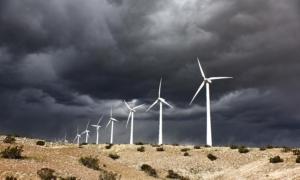The Biden administration has finalized a rule that will facilitate wind and solar energy development in ‘identified priority areas’ on public lands.
Wind and solar project developers on public lands will see an 80 percent drop in acreage rents and capacity fees under the Biden administration’s final Renewable Energy Rule, according to the U.S. Department of the Interior.
Interior Secretary Deb Haaland said in a statement on Thursday that the rule will facilitate wind and solar energy development in “identified priority areas” situated on public lands.
“The Interior Department will continue to advance projects that will add enough clean energy to the grid to power millions more homes and help ensure a livable planet for future generations,” Ms. Haaland said.
The bureau initially reduced these fees through guidance issued in 2022. The final provisions were established after the bureau gathered feedback from the public, industry stakeholders, and labor unions.
The department said the new rule codifies further reductions in acreage rents and reduces capacity fees by 80 percent through 2035, and then transitions to a 20 percent reduction for 2038 and beyond.
It will reduce consumer energy costs, improve renewable energy project application processes, and provide incentives for developers to use project labor agreements and domestic materials, according to the department.
In announcing the rule, Ms. Haaland said that the department has permitted more than 25 gigawatts of clean energy projects on public lands to power over 12 million homes across the country.
“Surpassing our goal of permitting 25 gigawatts of clean energy by 2025 underscores the significant progress we have made in helping build modern, resilient climate infrastructure that protects our communities from the worsening impacts of climate change,” she remarked.
The Biden administration has also leased eight new areas in “solar energy zones” with the capacity to generate nearly 2.5 gigawatts of additional clean energy, according to the statement.
BLM director Tracy Stone-Manning said that renewable energy projects on public lands are crucial in achieving the Biden administration’s carbon pollution-free power sector goal by 2035.
The bureau announced that two solar projects, the Arica and Victory Pass projects, in California, are now fully operational, adding 465 megawatts of clean electricity to the grid.
Transition to Renewable Energy Poses Challenges
A new Fraser Institute report said that while the cost of renewable sources has decreased, the challenge of land consumption—or how much space is needed for wind and solar power generation—remains an obstacle.
Mr. Green also said that more mines would be needed to get out of the ground the materials required for an energy transition to renewables.
Building wind turbines requires materials like iron ore, cement, and non-recyclable plastic for the blades. Solar hardware requires even more steel, glass, and concrete than wind turbines do, he said.
“Wind and solar power, in contrast to conventional forms of electricity production, exhibit a lower Energy Return on Investment (EROI) as they produce lower levels of electricity per unit cost.
“Societies which direct resources into lower-return endeavors, such as wind and solar power forsake the economic gains that would accrue from cleaving to energy sources that provide a higher economic return on investment, economic gains that are necessary for a society to prosper,” the report states.
Chandra Philip contributed to this report.
Original News Source Link – Epoch Times
Running For Office? Conservative Campaign Consulting – Election Day Strategies!


